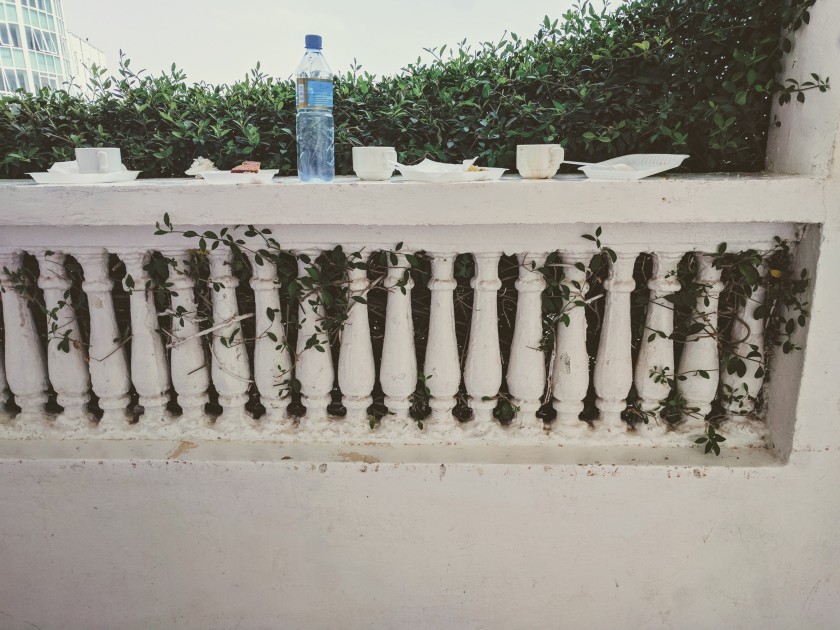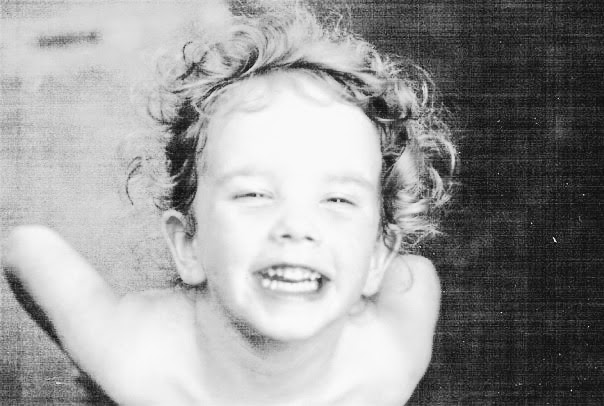When I was born, both of my parents worked, so at six months of age I was entrusted daily to an older Italian woman who ran a day care from her home. When I started kindergarten, the bookends of school days were also spent at Nana’s house; my parents dropped me to her early morning, I walked to and from school, only a block away, and they picked me up after work in the late afternoons.
To me, Nana’s house seemed a veritable castle, with high sloped roofs, abundant gables, even a turret, in the Queen Anne lineage of Victorian style. It was there that I spent much of my early childhood, and developed mythologies of my own making. While the outside was majestic, the interior was bold, new-Italian-American kitsch, imbued with an unquenchable decorative impulse for more. Over the years, Nana developed a penchant for ivy, and eventually the motif swallowed the ground floor, repeated from wallpaper to carpet to stencilling to the fake plastic garlands that hung over doorways. Where it was possible to put gold leaf, Nana put gold leaf, and mirrors covered at least one face of each room. Statuettes cluttered every surface beyond the reach of children: angels, Jesus-in-the-manger scenes, fruit and bread baskets, gold, pearl, silver, ceramic, you name it.

Up the stairs to the second floor, past the generous landing with opulent plastic plants and a glass case filled with more angel-baby-cornucopia figurines, each of five bedrooms boasted its own monochrome scheme. The first on the left was the pink room, each element a few shades darker than Pepto Bismol, from the walls to the carpet to the upholstery and bedding. It may sound cutesy, but I assure you that too much pink becomes sinister, especially with the curtains drawn; I would lunge past the doorway that yawned like a gaping mouth ready to swallow me into the small intestine of some malevolent chimera. A smaller room followed, with a narrow, high bed, everything gold, bronze, or wheat-colored, and tasselled, naturally. The green room in the far corner, layered in shades of chartreuse and spring grass, is where we were sent to rest if ill and potentially contagious, however ironically given the cartoon vomit-like colors. (I only ever spent a few hours there, because appetite was Nana’s primary indicator of health, and I almost never lost mine, no matter my ailment). Across from that invalid children’s suite was the blue room, where the turret hugged the house. It was massive, with fireplace and mantel, and an enormous four-poster bed. Lastly, Nana’s own bedroom echoed her preferred ivy patterning, and was full of light and green on white, with more plastic, tropical bouquets and ceramic angels.
We discovered magic everywhere in that house, pockets of wonder carried forth into reality by force of imagination. The enormous, slender ginkgo tree in the front yard stretched into the sky, extending its top-most branches in invitation to the giants who lived beyond the clouds. In the basement playroom, we were perennially on the hunt for elves who puttered about in dark corners, whose interest was piqued by the wooden curios and dolls from the 1970’s that we pulled from the toy box, and whose footsteps we could hear if we managed to stay silent long enough. The skirts of great pines in the backyard served as secret clubhouses, where we played hide and seek and worked out our fledgling identities, allowing entry only to some among us, depending on who we thought we were that day. In Nana’s house I was properly introduced to classical music, in particular through Disney’s Fantasia film, with its slender flamingos and chubby mushrooms gliding and tottering about to an enchanting score of Bach, Stravinsky, Beethoven, Tchaikovsky.

Nana wore an inviolable uniform of pastel muumuus to cover her large, mottled, wrinkled frame. She sported short, grey hair and a perpetual frown that occasionally transformed itself in short bursts of laughter before resuming its natural state. She was old enough to be long-set in her habits, which manifested in the food she served to us. Every two weeks her granddaughter drove her to the grocery store for bulk buying, long before it was trendy. She packed gallons of milk in the freezer, enough for a smattering of children in the interim period, unbothered by the icy chunks that filled our glasses at breakfast, or by the stench of sour milk that had sat too long but was served to us anyway, waste not want not. Nana cooked dozens of pancakes and wrapped them in plastic to freeze as well, unfortunately leaving the cling film attached when she microwaved them for us in the mornings, subsequently peeling off whatever plastic hadn’t coagulated with the scorching pool of Aunt Jemima’s syrup sitting underneath. She stirred enormous pots of spaghetti and meatballs and red sauce, probably her best dish, a far cry from the dry macaroni and cheese that showed up once in a while, with boiled hot dog slices pre-dipped in ketchup and tossed in for good measure.
I was a glutton for her peanut butter and jelly rolls, a world away from the pedestrian sandwich and a surprising culinary stroke: Nana flattened starched-white slices of Wonder bread, crusts jettisoned, into dense sheets with expert turns of a rolling pin, then smeared them, half with smooth Jiffy peanut butter, half with Smucker’s grape jelly, and rolled them tightly, jelly end first, tail-end sealed by the peanut buttered edge. The dense, heavy rolls were rich with flavor and quickly devoured. Nana’s coup de grace, though, was her Christmas confections. She doctored the humble sugar cookie with mastery, and rolled out long stretches of sweetened dough spiked with anise seed, cut into short lengths and hand-molded into S-shapes. She was a connoisseur of sprinkles, and knew just how children liked them: fully coating butter cookies from every angle. In the winter she packed the cookies into hefty glass jars set on the counter top, tempting tiny, greedy hands, ample incentive to finish our god-awful lunch plates.

Nana was not cruel, but she came from a school of child-rearing that encouraged grit, and she showed affection just often enough to remind you of the empathy buried somewhere amid the grumpy rigidity. Children were not to be coddled or placated; they were to bend to the will of adults, or go without. Tears were a waste of time; Nana refused to give in to tantrums, including the breathless, screaming, kicking variety. In the throes of a toddler’s conniption she would pull a paperback romance novel from her stack on the window ledge and calmly put on her reading glasses, wilfully ignorant to the wailing.
This strategy made the treats and small pleasures all the more exciting: swim time in the blue plastic pool on the sidewalk, grape Popsicle juice running down our sticky elbows; stuffing our faces with fistfuls of fluffy Orville Redenbacher double-butter popcorn during afternoon thunderstorms while we danced in front of mirrored walls to country music as the dark sky blackened the windows; sitting atop the heater grate on winter afternoons, wrapped in blankets, watching PBS with cups of Swiss Miss hot chocolate, the kind with mini marshmallows bobbing on top, and snacking on my favorite Christmas cookies, buttery shortbread stars striped with chocolate icing.

From Nana I learned about the complexities of love or, more accurately, about loving complex, imperfect people. Having been in her care for so long, I accepted her universe–and its rules–without question. But as I grew older, more thoughtful, and more reflective, her dictatorship was tarnished at times by overzealous style, and a short temper. I started to look after the youngest in the group, cleaning up their soiled underwear myself before she discovered it and wrought punishment. I sneaked them cookies they hadn’t earned because they couldn’t stomach a full glass of spoiled milk. And there were racial dynamics I didn’t quite grasp at that age, but I recognized as unjust. The same woman whose home was filled with a panoply of Patels, the children of Indian immigrant doctors, the same woman whose bright white dress contrasted starkly with her deeply darkened, southern Italian skin in wedding photos, would ask me point blank whether the young man at the front door with shovel in hand, offering his services to remove a foot of snow from the sidewalk, was Black, and if he was, to turn him away. And then she sent me outside in boots and snow pants, a nine-year-old, to do the same job.
As an adult, I no longer overlook abject discrimination or injustice. But in youth, opinions and attitudes are simply delivered to you, or fly right over your head, without your consent. When love is present, as it ought to be, before self-awareness ripens, when you find yourself yoked indelibly to someone with flawed character, you realize that it’s possible to love a person for their failures and faults, without loving the faults themselves. This kind of grey-area caring stretches your boundaries, forces you to face that squirrely, grace-filled, and all-too-common incongruity of facts versus feelings. Think of your parents, whose social or political views may seem to you narrow or outdated; think of the people who inhabited your formative years whose ways, upon reflection, seem backwards, ill-conceived, confusing; or of old friends who don’t fit neatly into your universe anymore, because of lifestyle differences, or a more simple, organic growing apart. Think of the partners who simply don’t see things the way you do, sometimes, and of the work it takes to reach around those differences and love each other anyway.

I visited Nana several years later as a near-adult, at her daughter’s house where she was staying because her health had taken a turn for the worse. She wasn’t entirely present that day, though she did remember me; she asked a few times what happened to my red hair, and where my freckles ran off to, both having faded since childhood, as though I would have reasonable and specific answers to those questions. Gazing quietly, she saw the version of me that she remembered, sifting through the most potent memories, holding fast to those in which she found value, or comfort, or beauty. I’ve done the same, in admiration of her fortitude and the generosity underlying it, remembering her character for its greatest attributes, and allowing the less-savory traits to fall away, having learned from them, and no longer needing them to preserve her best memory.
We do this for one another, we overlook or underplay the rough edges, the wrongful comments, the omnipresent ceramic babies Jesus that make us wince a bit. If we do this responsibly, in a measured way, if we manage not to betray our personal ethics, we can love around the hard corners, through the awkward moments and the tacky ivy motifs, uplifting the best in one other.


Oh that’s a gorgeous post of memories, thank you for sharing so eloquently.
LikeLiked by 1 person
Really nice of you to say! Hope all is well!
LikeLiked by 1 person
Some part of your childhood reminded me about mine,when we grow up we learn to love even the imperfection of people close to us,nobody is perfect but everyone can learn about love:)
LikeLiked by 1 person
Glad to hear it resonated! And I totally agree with the sentiment. Well wishes to you!
LikeLiked by 1 person
Pingback: mid-week link love | outerNotes
Beautifully written.
LikeLiked by 1 person
Thank you kindly! Sending you well wishes!
LikeLike